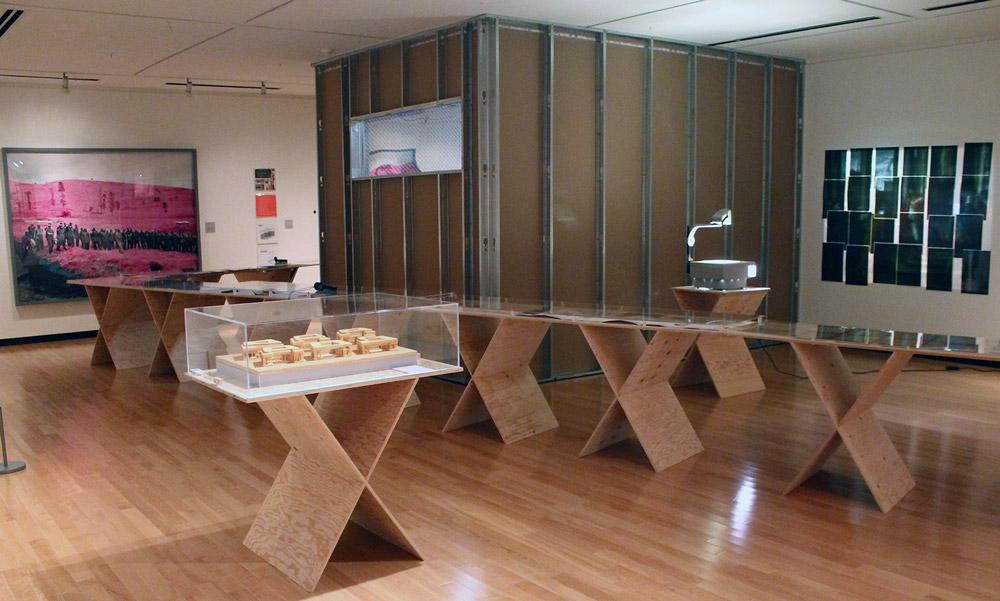Complex, dense and far reaching, the artworks, documents and other ephemera assembled by Berlin-based Canadian artist Charles Stankievech for his latest curatorial project at the Justina M. Barnicke Gallery, “Counterintelligence,” begin to map a nuanced diagram of the (often surprising) interrelations between art and the military, state-controlled intelligence and deftly played acts of resistance.
The exhibition reads as a story of two parts. The first considers the role of the virtual within the military, while the latter spans the furthest possible reaches of time, place and reference materials to produce a furtive, moving shadow of war.
The initial two rooms of the show are immersive, confrontational and loud, housing videos culled from a variety of sources and taking the war in Iraq as a jumping off point. Filmmaker Harun Farocki’s Serious Games IV: A Sun (2010) contrasts simulation software created by the US military for training with those produced to address the traumatic experiences of soldiers post-combat. The juxtaposition of the simulated imagery with its real-world applications (training and therapy) reveals both the financial disparity between the two (less money is spent on the therapeutic video) as well as the ways that virtual reality can supplant and mutate the real experience of modern warfare. The distance produced between the two can be read on the faces of the young male soldiers as they navigate their virtual training ground. If you didn’t suspect it before, you could surmise that backlight screens and keyboards have effectively replaced drills and basic training.
Stankievech reinforces this relationship between video games and war with two projected videos in the adjoining gallery space. The first game was developed by the US Army, presumably as a soft-recruitment tool; the second, titled Special Force, was published by Hezbollah in 2003 with the objective to defeat the Israeli army. Directly opposite, the grainy surveillance imagery of Collateral Murder plays decrypted footage recently obtained and circulated by Wikileaks, imploring viewers to watch the violent reality of military-related deaths. Captured by a camera affixed to an Apache helicopter flown by US troops, the clip shows American soldiers opening unprovoked fire on civilians and journalists. The ramifications of militarized video game practices and the disconnect between the soldiers enthusiasm and the unfolding imagery remains hard to digest and has lingered in the darker corners of my memory since viewing. But the profound ethics of bearing witness has also persisted, a testament to the power and potential of difficult imagery.
The exhibition shifts towards the archival and documentary in the Barnicke’s main gallery. A central angular vitrine holds a stockpile of visual, textual and digital materials. These pieces provide Stankievech’s most substantial argument for the roles artists have played as both allies and foes in state games of war. The long history of landscape artists as spies and artistic investment in the development and design of camouflage—from Abbott Thayer’s theory of concealing coloration to the abstract distortions of First and Second World War dazzle ships—are highlighted alongside Paul Virilio’s seminal Bunker Archaeology (1975) and Sang Mun’s typeface ZXX (2012), designed to defy digital surveillance systems (all title panels in the exhibition feature the font).
Opposite the case is a gaping pentagonal void carved from the gallery wall. For Study for a Blue Shield (2011), Abbas Akhavan has painted the removed drywall with the blue and white crest of The International Committee of the Blue Shield then installed the resulting work on the roof of the gallery for the duration of the exhibition. (During the opening, the painted shield was propped against a wall adjacent to the gallery entrance.) Designed in 1954 by The Hague, the Blue Shield symbol was created to identify cultural institutions worldwide and prevent their destruction during international conflicts. Notably, this symbol was painted atop the roof of the National Museum of Iraq in 2003 to guard against its destruction during aerial bombings, a gesture that did not prevent massive looting of the institution following the American invasion. Cori Wegener, founder of the US Committee of the Blue Shield, has lamented the slow response by the American government during the Iraq War to protect cultural heritage. This blatant disregard for the importance of “foreign” culture can be viewed as an extension of the insidious tools of modern war being enacted in the Middle East.
In a way, the success of Akhavan’s project lies in our trust that the hidden twin is in fact installed on the roof. Unlike an early iteration of the piece at Art Berlin Contemporary in 2011, there is not yet any visual documentation of its placement there. This assumption underlies a central undercurrent that runs through the show—namely, that we are required to believe that the trust we sacrifice, or is demanded from us, in the names of war and security is necessary and worthwhile. Consider the rupture of privacy and personal information of citizens monitored via cell phone and Internet use; or state secrets extracted within the confined walls of interrogation rooms; or the redacted lines of government documents, withheld for our own best interests. Our sensitivity to the horrors of conflict have been conditioned and numbed through virtual simulation and geographic distance. And what of the rationalization of the loss of human life as collateral damage and the so-called cost of doing business? As “Counterintelligence” proves, if we had imagined that the realms of art, its cliques, globalized networks and markets were somehow beyond these reaches, we’ve been sorely, and perhaps intentionally, misled.









